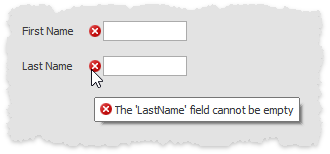DXErrorProvider.ContainerControl Property
Gets or sets a control which owns the controls monitored for errors.
Namespace: DevExpress.XtraEditors.DXErrorProvider
Assembly: DevExpress.XtraEditors.v25.2.dll
NuGet Package: DevExpress.Win.Navigation
Declaration
[DefaultValue(null)]
[DXCategory("Behavior")]
public ContainerControl ContainerControl { get; set; }Property Value
| Type | Default | Description |
|---|---|---|
| ContainerControl | null | The ContainerControl that contains the controls monitored for errors by the DXErrorProvider. |
Remarks
A DXErrorProvider component can be used to track errors on the data source level, and automatically display any error within bound editors. In this mode, the ContainerControl property must be set to the control which owns bound editors. Typically, this is a form. If the ContainerControl property is not set, errors will not be displayed within bound editors.
When adding a DXErrorProvider to a form at design time, the ContainerControl property is set to this form automatically. When creating a DXErrorProvider in code, the property must be initialized manually.
Refer to the DXErrorProvider.DataSource topic, for information on handling errors on the data source level.
Example
The following example demonstrates how to implement error notifications for a custom business object at the data source level, using the IDXDataErrorInfo interface. Error information will be handled by the DXErrorProvider component, which will indicate any error to an end-user.
In this example, the business object is represented by a custom MyRecord class. It contains two properties (FirstName and LastName) that cannot be empty. This class’ records are stored in a BindingSource component and edited using text editors (the FirstName and LastName properties are edited in a textEdit1 and textEdit2 controls respectively).
The requirement is to visually indicate errors within the editors, if the record’s FirstName or LastName property contain an empty string. In this example, the error information is provided on the data source level. The MyRecord class implements the IDXDataErrorInfo interface and returns the error information via the IDXDataErrorInfo.GetPropertyError method. To display the supplied errors within the editors, a DXErrorProvider component needs to be added to the form. It indicates errors as error icons, which can be hovered over to display error text.
To automatically track errors supplied by a data source, the DXErrorProvider component must be bound to this data source via the DXErrorProvider.DataSource property. In this example, the DXErrorProvider.DataSource property is set to the BindingSource.
The following image illustrates the resulting form after it has been opened at runtime. The editors contain empty strings, and as a result error icons are displayed within the editors:

using DevExpress.XtraEditors.DXErrorProvider;
private void Form1_Load(object sender, EventArgs e) {
// Specifies the type of records stored in the BindingSource.
bindingSource1.DataSource = typeof(MyRecord);
// Creates an empty MyRecord and adds it to the BindingSource.
MyRecord rec = new MyRecord();
rec.FirstName = "";
rec.LastName = "";
bindingSource1.Add(rec);
// Binds the text editors to the MyRecord.FirstName and MyRecord.LastName properties.
textEdit1.DataBindings.Add(new Binding("EditValue", this.bindingSource1,
"FirstName", true));
textEdit2.DataBindings.Add(new Binding("EditValue", this.bindingSource1,
"LastName", true));
// Binds the DXErrorProvider to the data source.
dxErrorProvider1.DataSource = bindingSource1;
// Specifies the container of controls (textEdit1 and textEdit2).
dxErrorProvider1.ContainerControl = this;
}
// A custom record class.
public class MyRecord : IDXDataErrorInfo {
private string firstName;
private string lastName;
public MyRecord() { }
public string FirstName {
get { return firstName; }
set { firstName = value; }
}
public string LastName {
get { return lastName; }
set { lastName = value; }
}
// Implements the IDXDataErrorInfo.GetPropertyError method.
public void GetPropertyError(string propertyName, ErrorInfo info) {
if (propertyName == "FirstName" && FirstName == "" ||
propertyName == "LastName" && LastName == "") {
info.ErrorText = String.Format("The '{0}' field cannot be empty", propertyName);
}
}
// IDXDataErrorInfo.GetError method
public void GetError(ErrorInfo info) { }
}
Related GitHub Examples
The following code snippet (auto-collected from DevExpress Examples) contains a reference to the ContainerControl property.
Note
The algorithm used to collect these code examples remains a work in progress. Accordingly, the links and snippets below may produce inaccurate results. If you encounter an issue with code examples below, please use the feedback form on this page to report the issue.